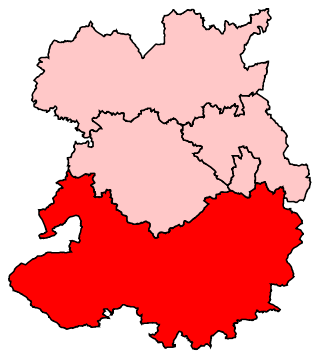Related Research Articles

Shropshire is a ceremonial county in the West Midlands of England, on the border with Wales. It is bordered by Cheshire to the north, the Welsh county of Wrexham to the north and northwest, Staffordshire to the east, Worcestershire to the southeast, Herefordshire to the south, and the Welsh county of Powys to the west. The largest settlement is Telford, while Shrewsbury is the county town.

West Mercia Police, formerly the West Mercia Constabulary, is the territorial police force responsible for policing the counties of Herefordshire, Shropshire and Worcestershire in England. The force area covers 2,868 square miles (7,430 km2) making it the fourth largest police area in England and Wales. The resident population of the area is 1.19 million Its name comes from the ancient kingdom of Mercia.

Much Wenlock is a market town and parish in Shropshire, England; it is situated on the A458 road between Shrewsbury and Bridgnorth. Nearby, to the north-east, is the Ironbridge Gorge and Telford. The civil parish includes the villages of Homer, Wyke, Atterley, Stretton Westwood and Bourton. The population of the civil parish, according to the 2001 Census, was 2,605, increasing to 2,877 by 2011.
Shropshire was established during the division of Saxon Mercia into shires in the 10th century. It is first mentioned in 1006. After the Norman Conquest it experienced significant development, following the granting of the principal estates of the county to eminent Normans, such as Roger De Montgomery and his son Robert de Bellême.

The English county of Shropshire has a fairly large railway network, with 19 National Rail stations on various national lines; there are also a small number of heritage and freight lines, including the famous heritage Severn Valley Railway running along its eastern border with Worcestershire.

Ludlow was a constituency in Shropshire represented in the House of Commons of the UK Parliament.

The Shropshire Star is reputedly the twelfth biggest-selling regional newspaper in the UK. It is based at Grosvenor House, Telford where it covers the whole of Shropshire plus parts of Herefordshire, Worcestershire, Staffordshire, Cheshire and Mid Wales. It is printed by Newsquest at their Deeside office.

Warwickshire Police is the territorial police force responsible for policing Warwickshire in England. It is the second smallest territorial police force in England and Wales after the City of London Police, with only 823 regular officers as of September 2017. The resident population of the force area is 554,002.
The West Midlands Constabulary was a police force in the West Midlands of England.
Sir Douglas Osmond was the chief constable of Shropshire Constabulary and later Hampshire Constabulary.

South Shropshire is a county constituency in Shropshire. It was first created in 1832 and was represented by two Knights of the Shire.
Herefordshire Constabulary was the Home Office police force for the county of Herefordshire, England, from 1857 until 1967.

Worcestershire Constabulary was the territorial police force responsible for policing rural Worcestershire in central England from 1839 until 1967, when it became part of West Mercia Constabulary.

Buckinghamshire Constabulary was the Home Office police force for the county of Buckinghamshire, England, until 1968.
The New Year Honours 1915 were appointments by King George V to various orders and honours to reward and highlight good works by members of the British Empire. They were announced on 1 January 1915.
The North Midlands Rugby Football Union is a governing body for rugby union in part of The Midlands, England. The union is the constituent body of the Rugby Football Union for the counties of Herefordshire, Shropshire, Worcestershire and the Greater Birmingham area.

The West Mercia Police and Crime Commissioner is the police and crime commissioner (PCC), an elected official tasked with setting out the way crime is tackled by West Mercia Police in the English counties of Herefordshire, Worcestershire and Shropshire. The post was created in November 2012, following an election held on 15 November 2012, and replaced the West Mercia Police Authority. The current incumbent is John Campion, who represents the Conservative Party.
References
- ↑ "British Police History". british-police-history.uk. Retrieved 2020-07-08.
- ↑ "Conservation of West Mercia Police records – Worcestershire Archive & Archaeology Service". www.explorethepast.co.uk. Retrieved 2020-07-08.
- ↑ "Shropshire Constabulary and Shrewsbury Borough Police - WW2". Imperial War Museums. Retrieved 2020-07-08.
- ↑ Council, Shropshire. "Shropshire Community Directory - West Mercia Police (Bridgnorth)". search3.openobjects.com. Retrieved 2020-07-08.
- ↑ Neal, Toby. "Former Shropshire police chief dies at 95". www.shropshirestar.com. Retrieved 2020-07-08.
- ↑ Smith, Rory. "Coronavirus: Police increase patrols after lockdown breaches in Bridgnorth, Oswestry and Much Wenlock". www.shropshirestar.com. Retrieved 2020-07-08.
- ↑ Johnstone, Janet (2016-08-31). Oswestry and Whitchurch in the Great War. Pen and Sword. ISBN 978-1-4738-4385-1.
- ↑ "Shropshire Constabulary, 1859". Shropshire Archives. Retrieved 11 July 2018.
- ↑ New Police Chief Gives Up Post. Derby Telegraph . 6 February 1946. p. 8